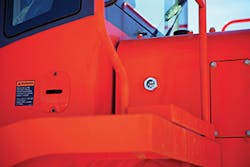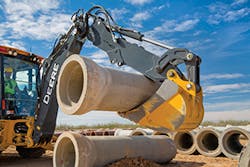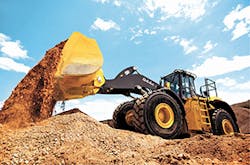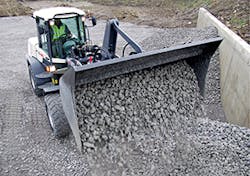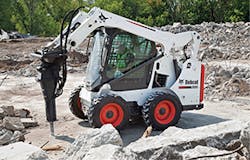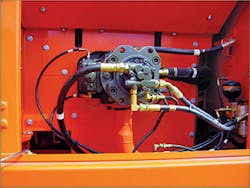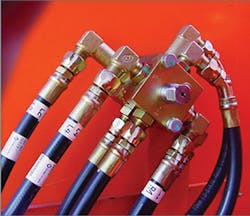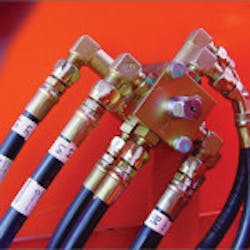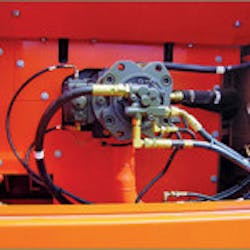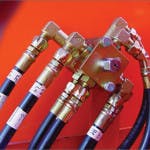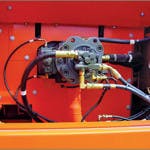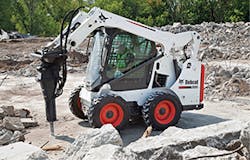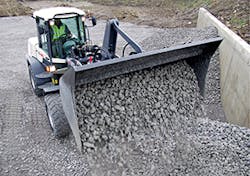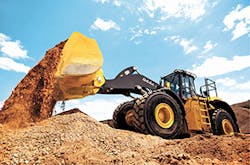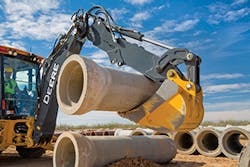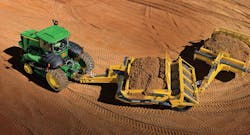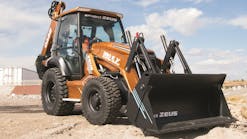The hydraulic machinery used in construction today owes its success to a long heritage of fluid mechanics, the practical application of liquid in motion. An ancient science, hydraulics heralds a lineage tracing back to the Egyptians and Babylonians, who built canals for irrigation. But it was the Greeks who studied pressure and flow patterns, designing hydraulic equipment like the piston pump and water clock.
Ideas were further advanced during the Renaissance, when Leonardo da Vinci documented frictional resistance and velocity of surface waves. When mathematics and physics were incorporated in the 17th century, logical patterns were detected, leading to the academic discipline of hydrodynamics. A century later, French and German scientists learned how to measure flow velocity and developed principles of flow measurement. Hydraulic power is defined as flow times pressure.
Pattern control valve
In the following century, experiments were designed to study the effects of temperature on flow and understand the nature of fluid viscosity. Since then, refinements have been made to further understand frictional resistance.
History and Evolution
Refinements led to advances in hydraulics, but, while improvements and changes continue, “for the most part, the basics of a hydraulic system are the same,” states Curt Leair, rental accounts service manager for Terex Construction Americas. After all, he says, “hydraulic machines all have the same basic components: the engine, hydraulic pump, hydraulic valve, hydraulic motors, and hydraulic cylinders.”
But while the same basic concepts of hydraulics have been around for nearly 25 years, including the base architecture of many of the electro-hydraulic (EH) systems we use today, continued advancement has occurred in three main areas of the hydraulics control system: joystick (input), actuator (output), and sensor (feedback) technology, claims Jeff Bauer, senior engineer, hydraulic product verification for John Deere Construction & Forestry. “[They] have matured to a very high level of reliability and cost effectiveness, allowing EH systems to be utilized on almost every piece of construction equipment today.”
Hydraulic pump
It was a “basic system in the early days,” judges Mike Fitzgerald, loader product specialist for Bobcat. “Today, they have higher performance and are a longer-lasting, more efficient machine with faster cycling and more versatility.”
Engineers have designed high-performance hydraulic systems to give operators the ability to run multiple machine functions simultaneously without sacrificing power or performance. Increased hydraulic pressure and flow can power multiple functions at once, increasing efficiency. Says Leair, “A modern hydraulic system will allow the operator the ability to run boom, stick, and swing functions in a smooth, precise, and efficient manner. These vastly improved hydraulic systems give these machines the strength and agility to allow operators to maximize job-site performance, increase productivity, and generate contractor profitability.”
Modern hydraulics systems are more efficient than they used to be, confirms Gary Kassen, engineering director for hydraulics and pneumatics, CNH Industrial. “They’re much smarter than they used to be, and they’re more reliable. That plays into CASE’s larger goal of making equipment more practical and intuitive to use, while also improving on the power needed to get work done.”
One of the ways they’ve done that is by switching from fixed displacement work pumps to variable displacement. The pump puts out only as much flow as is needed. “Traditionally, a lot of construction equipment used fixed displacement,” explains Kassen. “If you only needed to make minor adjustments to your work function, most of the flow was being dumped over a relief valve, which created extra heat in the system. By having a variable displacement, you only produce as much flow as needed.”
Designing equipment with more pumps also increases efficiency. By putting in multiple pumps and separating steering from the work circuit, it’s possible to match the pumps to the pressures that are needed and reduce throttling losses.
Part of the reason modern hydraulics are more efficient today than they were 20 years ago stems from the diminished need for higher horsepower engines to run the system, claims Corey Rogers, marketing manager at Hyundai Construction Equipment. This also contributes to better fuel efficiency. “We use different pump technology: an inline stacked pump technology.” Like CASE, Hyundai offers variable volume piston pumps that vary the flow, based on demand. Instead of fixed displacement pumps running at velocity—whether needed or not—burning fuel unnecessarily. These pumps have the ability to destroke and minimize flow when demand is low.”
Over the years, hydraulic systems in construction equipment have evolved from low-pressure, open-center systems to much higher-pressure, closed-center, load-sensing, electro-hydraulic systems, says Deere’s Bauer. “Thirty years ago, 3,000 psi was considered high pressure. Today, that would be considered low pressure. Many implemented hydraulic systems are capable of 4,000 psi. Most excavators are 5,000 psi, and most hydrostatic propel systems run at 6,000 psi.”
Terex TL120 wheel loader
The push for higher pressures is to reduce actuator size. Higher pressures allow some equipment designs to use smaller bore cylinders to produce the same power. Smaller cylinders require less flow to achieve the same speed. This in turn allows for a smaller pump. Thus, with higher pressure, the entire system becomes more compact while delivering the same overall power.
Power density is one driver in hydraulic advancements. Others include reduced operator fatigue through ease of operation and improved system efficiency. “EH systems provide much easier function control with ‘shorter-throw’ joysticks and greatly reduced lever efforts,” continues Bauer. EH also provides some automated or assisted implement controls designed to reduce cycle times and improve accuracy.
Variable displacement pumps coupled with load-sensing hydraulic valves greatly improve system efficiency by pumping oil only when it is required. “The constant displacement gear pump used on most systems years ago pumps oil all the time,” recalls Bauer. “Even when the hydraulics are providing no work, engine power is lost to the hydraulic system due to this constant flow.”
In addition to being more efficient, modern hydraulics are also smarter. “Manufacturers have gone from hydro-mechanical systems to electro-hydraulic systems,” says Kassen. “With that comes improved functionality. That may be an automated function, more productivity choices, or just easier-to-select options.”
From mechanical levers and pedals to pilot controls, hydraulic controls have evolved to electronic over hydraulic. While a large percentage of contractors still prefer simple basic systems with mechanical foot pedal hydraulic controls because they are reliable and cost less, Fitzgerald says some prefer joysticks for operator comfort. “We try to accommodate operator preference by providing three different style controls: hand lever steering and foot pedal hydraulics; advanced controls system (foot pedals or hand levers for lift arm and bucket); and selectable joystick for the drive and hydraulic functions.”
Hydraulic systems are becoming very advanced, and hydraulic pressures are being monitored by the machine control, which then adjusts the hydraulic system to optimum performance. The most dramatic improvement in hydraulics is the interface between controls and the hydraulic system, notes Mike Stark, product specialist of wheel loaders, material handlers, and log loaders for Doosan. “Sensors have been added to [detect] pressure changes in the system so the machine’s hydraulic system can be automatically adjusted to the requirements of the job, he continues. System response times have improved when power is needed.
Maintenance
Efficiency, productivity, and life expectancy are impacted by proper care and regular maintenance. From a maintenance standpoint, Deere’s Bauer sees little difference in today’s hydraulic systems. “They still require fluid and filter changes as regular maintenance.”
However, advancements in hydraulic fluid technology have pushed service intervals out to several thousand hours. Pumps and actuators still need replacement as systems age, but today’s more complex electro-hydraulic systems are much more sensitive to contamination.
“It is vitally important to keep the hydraulic fluid very clean or there will be performance issues,” insists Bauer. What was considered clean 20 years ago would now be considered unacceptable.
Sampling for contaminants and to detect unusual wear is important. Following the recommended service intervals is also important. “We advise taking samples at approximately 500 plus hours, especially in harsh conditions,” suggests Stark.
Ports should be easily accessible to encourage regular monitoring, and should allow for service from the ground level as much as possible. “Serviceability is the key,” says Stark. “It needs to be convenient and safe.”
Everyone knows that maintenance is key, but Stark adds a word of caution about maintenance practices: “Make sure the oil you’re putting in is good quality and for the correct temperature and weather. Don’t contaminate what you put in [by using] a dirty funnel.” It’s also not a bad idea to pre-filter.
“It’s very important to keep systems clean,” agrees Bobcat’s Fitzgerald. “It’s critical to have clean oil—and the right oil—for hydraulics systems.” Oils are better today, he says, with specific additives designed for hydraulic systems to provide longer component life. Without proper lubrication, small water particles can float, causing damage.
Filtration is important too. Bobcat uses larger filters to provide extended service intervals, says Fitzgerald. Doosan uses a finer mesh. Better materials can contribute to extended intervals. Regardless of size or material, it’s best to stick to recommended service intervals for maximum component life and performance. Improper filtration can also hinder performance. If, for example, filters become plugged, the machine is forced to use more horsepower to perform.
At least every six months, hydraulic filters should be changed on older machines, advises Terex’s Leair, and machines should get a complete annual once-over that includes replacing hydraulic oil, the water separator/fuel filter, and the fuel filter element.
An auto-lube option is a time-saving system that Stark says is commonly requested on large Doosan wheel loaders because it provides the correct amount of grease for the hours worked. Under-greasing or not greasing is more common without an auto-lube system, but manually over-greasing is also an issue in some cases, he says. “If the machine is in a dusty application, the over-greased areas can collect dirt, which could cause unusual wear.”
Because it also saves grease by not over-greasing, an auto-lube system offers a financial benefit. It can be especially useful on big jobs with extended hours that prevent the typical checkpoint intervals or opportunities to re-lube. “If you’re working 10 hours, auto-lube keeps working,” he points out.
Auto-lube systems are designed to self-monitor to detect failure and broken or plugged lines, but most big machines are also equipped with monitoring that allows an operator to keep an eye on things from the cab, set up service intervals, and even perform some minor diagnostics. “There are more pieces to watch [in today’s hydraulics systems],” but they have built-in warnings,” says Fitzgerald.
“A dash display allows operators and service technicians to monitor pressures and diagnose problems in the cab without connecting to a computer,” adds Stark. The electronic interface between the hydraulic system and the operator is an important development that improves efficiency. Customers have deadlines; if the equipment is down for hours, it’s “big money,” he says, because “it’s not easy to get replacement equipment to the job site.”
In some ways, hydraulics are easier to maintain, believes CNH’s Kassen. “With traditional hydro-mechanical systems, it was sometimes difficult to find where the malfunction was. With electro-hydraulics, we can build in intelligence that can self-diagnosis the problem. Is it a pump issue? Is it a filter issue? What’s causing the malfunction? We’re making it easier for the operator to understand what’s wrong.”
It’s important that the operator also understand the impact cleanliness can have on maintenance. For example, if the tip of the grease gun is dirty, it introduces contaminants, which can shorten service intervals. “Cleanliness comes down to the person doing the service,” observes Stark. “You can have a nice machine and do regular service, but if the tools used to service the machine are dirty, it doesn’t matter.”
As Bauer explains, technicians must train to be able to troubleshoot issues on today’s more complex hydraulic systems, and more often than not, the issue is caused by contamination. The environment this equipment operates in is dusty, dirty, or wet, and the source of many potential contaminants; the person servicing the machine shouldn’t be introducing contamination before the equipment ever gets to the job site.
“You can recognize a good operator by how the machine looks,” concludes Stark. “Some are very proud of their equipment and take care of it.”
John Deere 844K II wheel loader
Talking Points
Hydraulics are more than merely a talking point for dealers. Today’s operators are concerned about hydraulic system performance in two main areas, first and foremost productivity, says Bauer. “This is what ultimately gets the job done and puts the food on the table. The better the productivity, the more jobs can be done in a day, a week, or a year, which puts a lot more food on the table.”
The second area is efficiency. A more efficient system can produce the same work with less fuel usage. Lower fuel usage reduces operating cost. “There is a balance in performance between productivity and efficiency,” continues Bauer. “Machines that excel in both areas are highly sought-after.”
Adding to both, advances in hydraulic technology provide ease of use. Changing attachments, tools, or buckets used to take either two people or several minutes, explains Bauer. “Now it can be done from the cab. Level grade used to be accomplished with stakes, tapes, and string. Today, it is done with site mapping and laser guidance, making it much more accurate and faster.”
Because flow and pressure work together to increase the productivity of the unit and how efficient the unit will be when carrying high-demand attachments, the hydraulic pressure of a machine is important to consider. However, says Leair, it’s often overlooked in the purchase decision, especially the auxiliary hydraulics. “Most contactors are only concerned with the flow capabilities of the unit; they seldom consider the pressure and how this affects the overall performance of the machine and any attachments it will be operating. For example, buyers need to be sure that the pressure of the unit matches the specification of the attachment—too much flow can damage hydraulic drive motors and solenoids inside the attachment. And if the attachment does not have enough pressure, it will not perform correctly.”
Only once the amount of pressure needed is established do buyers have to consider the flow and pressure as a combined force and how this will affect their productivity. By being able to calculate the hydraulic horsepower of the unit, buyers can then pick the best unit for maximum productivity. Calculating hydraulic horsepower is simple: take the GPM, or flow of the unit, and multiply it by the psi, or pressure, then divide that total by the constant, which is 1,714. Here’s an example to better illustrate: a unit with 45 GPM and a pressure of 3,800 psi would have a hydraulic horsepower of 99.7.
“The most important thing is what the machine does for the customer,” sums up Kassen. Getting more work done and being more comfortable while doing it sells machines and is what operators and dealers are interested in, he believes.
Highly skilled drivers will find the learning curve short with John Deere’s automation control software on certain earth grading equipment, which Bauer says will improve productivity while further enhancing ease of operation. Motor graders have an option called “cross-slope” that allows the operator to focus on one corner of the blade while the computer controls the other. “This allows for faster ground speed while grading, and also provides for a more accurate cut.”
Hydraulic systems today are more efficient and higher performing due to increased flows and pressures, producing faster cycle times. They also provide versatility. Instead of dedicated machines that often sat unused, machines can easily swap attachments for more productivity. “The increased hydraulic performance allows customers to add specialized attachments for versatility,” emphasizes Bobcat’s Fitzgerald. He lists trenchers, planers, wheel saws, and brush and forestry cutters, all of which perform
better with higher flows and pressures. “Customers can replace dedicated machines that may not have high utilization with a skid-steer or compact track loader and several attachments that increase their efficiency and profitability.”
John Deere 310SL backhoe
Hydraulic Hybrid
For many customers, fuel cost is their highest cost of ownership. Hybrid machines can be more efficient and save them money. For example, an excavator swing system sees a lot of braking. Storing that wasted energy in an accumulator saves fuel, making a machine up to 50% more efficient.
“We chose hydraulic hybrid technology for the excavator because the electric hybrid cost was prohibitive,” says Randy Peterson, chief engineer for Cat hydraulics at Caterpillar. One of the benefits of that choice was familiarity. “An electric system would have required new learning [for maintenance]. We started with a foundation of familiar, proven technology and integrated differently.”
He calls the integration of components and electronic controls Cat’s “secret sauce.” The 336E H hybrid excavator, a Tier IV interval machine first produced in 2013, and its successor, the 336F XE, a Tier IV final machine, offer precise control with lower fuel consumption. A larger electronic pump enables speed reduction on the engine for increased efficiency while electronic control provides more response and more precise control of the hydraulic flow, supplying just enough power where and when needed. An integrated electronic-controlled fly-by-wire valve is the adaptive control system behind the new technology—an industry first, adds Peterson.
“The reliability is phenomenal,” exults Peterson. “It has the intelligence of electronics and the muscle of hydraulics.” He says it has the same or better performance as a standard machine, despite the perception that a hybrid would be slower and less powerful because it’s quieter. “The engine speed dropped from 1,800 to 1,500 rpm, but its power rating is the same; it has muscle.”
It’s also easier to diagnose and maintain, he says, with service intervals that keep growing. “You can go 3,000 hours or more on hydraulic oil changes with good maintenance practices.”
Good Maintenance Practices Start With the OEM
Contaminants can easily be introduced during the change of attachments if the connectors aren’t clean, points out Steve DePriest, product specialist with Hyundai Construction Equipment.
Equipment manufacturers are designing machines for easier serviceability, as well. Pressures can be checked in real time from the cab. “Our wheel loaders are equipped with a quick drain so there’s little chance of backflow contamination,” says Rogers.
Other state-of-the-art technology from Cat include bushings treated for corrosion-resistance; filters on breathers; multistage filtration that includes a sump screen and return filter to decrease contamination; remote-mounted filters with ground-level access behind the compartment door so they are out of the weather; and the ability to set when and how long and how often to lube from the cab.
Dan Beverley, Cat’s district service rep, offers other suggestions, such as using high-life oil for extended service intervals so the operator is not opening the hydraulic tank as often and risking further contamination. New oil should be filtered—although he realizes that most people don’t clean new oil.
Another key is to address the type of application and the number of working hours, and adjust the intervals in accord with the severity. “Manuals are based on a standard environment,” he says.
Future for Hydraulics
Peterson envisions Caterpillar making pump controls more intelligent to handle any environment. He also thinks hydraulic hybrid technology will continue to expand. “We’ll leverage the technology across other products to store and recover wasted energy through integration of systems for more power and efficiency to reduce total cost of ownership for our customers.”
Automation will grow transparent, believes Peterson. It’s what “makes a less skilled operator look good and makes an expert even better with information about grade level.”
Higher productivity and ease of use can be achieved through automation. Kassen says CASE “will continue to look at ways to automate functions for the operator—to make it easier for an inexperienced operator to perform at a higher level and to have an experienced operator be able to get more work done than they’ve ever been able to in the past.”
Automation, including GPS control on a grader blade for levelling, will become more prevalent, predicts Fitzgerald, especially as the cost comes down. “It’s very accurate, but it has to be cost effective in compact equipment.”
An element of cost effectiveness is the ability of the operator to multi-task without losing power because the oil flows to multiple functions simultaneously. “This can only happen because of a load-sensing controller that senses which function has the highest load pressure and then feeds this flow requirement immediately to the pump,” explains Terex’s Leair.
Because compact excavators were not engineered with auxiliary hydraulics when first introduced, they were known for their “herky-jerky, unresponsive-underpowered motion,” he says. “The machines were constructed with only hydraulics for the basic joystick functions.” Compact excavator owners had to re-plumb their hydraulics to divert flow to additional systems in order to run multiple functions at once. Typically, this resulted in lower flow to the machine’s main functions, giving the machines a slow, sluggish, jerky response and imprecise control.
Therefore, the evolution of hydraulic systems—and the future—is all about the control of the hydraulic fluid, insists Leair. “With new electronics being integrated into loader designs, the future of hydraulics will be about the control of fluid and how the machine’s systems [have the] ability to communicate with each other.” This control of hydraulic oil is referred to as load independent flow division. Hydraulic oil is supplied to the motors and cylinders, per operator commands, without regard to what other functions are being operated.
Controlling the flow promotes flexibility. “Our M Series dozers have different levels of blade control,” says Kassen. “If you’re doing a finishing grade, you may want a slower response so it’s as smooth as possible. If you’re trying to move as much dirt as possible, you can set it to a more aggressive level. We’ve got that flexibility built into the machine through hydraulics, and we’re building more into future machines.”
CASE is also adding functionality that improves the productivity of the operator, such as automatic ride control, auto height control, and max height control—all of which can be set in the cab versus mechanical adjustments outside of the vehicle. “As soon as the operator digs into a pile, they have the rigidity they want, and then when they get back up to a traveling speed, the ride control function automatically kicks back in and provides a smoother ride. Those are just some of the examples where hydraulics has made it easier for the operator to do their job and improve their productivity,” notes Kassen.
“There’s no debating that Tier 4 has changed the way equipment is designed,” he continues. Engines run cleaner, machines run cleaner. But, he points out, “CASE has made a specific effort to go beyond compliance and provide greater power and performance with Tier 4 machines, and hydraulics play a big part in that. Our Tier 4 engines are significantly quieter than Tier 3 engines, so operators are going to notice that the cab is quieter than it used to be.”
Increased performance and lower maintenance costs (due both to better manufacturing processes and to better oils and additives) are the future, says Fitzgerald. Electronic controls inside the cab will enable an operator to change attachments more quickly and easily. “One guy can add a breaker for concrete, a grapple to move material, a bucket to level, or a vibratory roller to pack material. Versatility enables small contractors to be more competitive.”